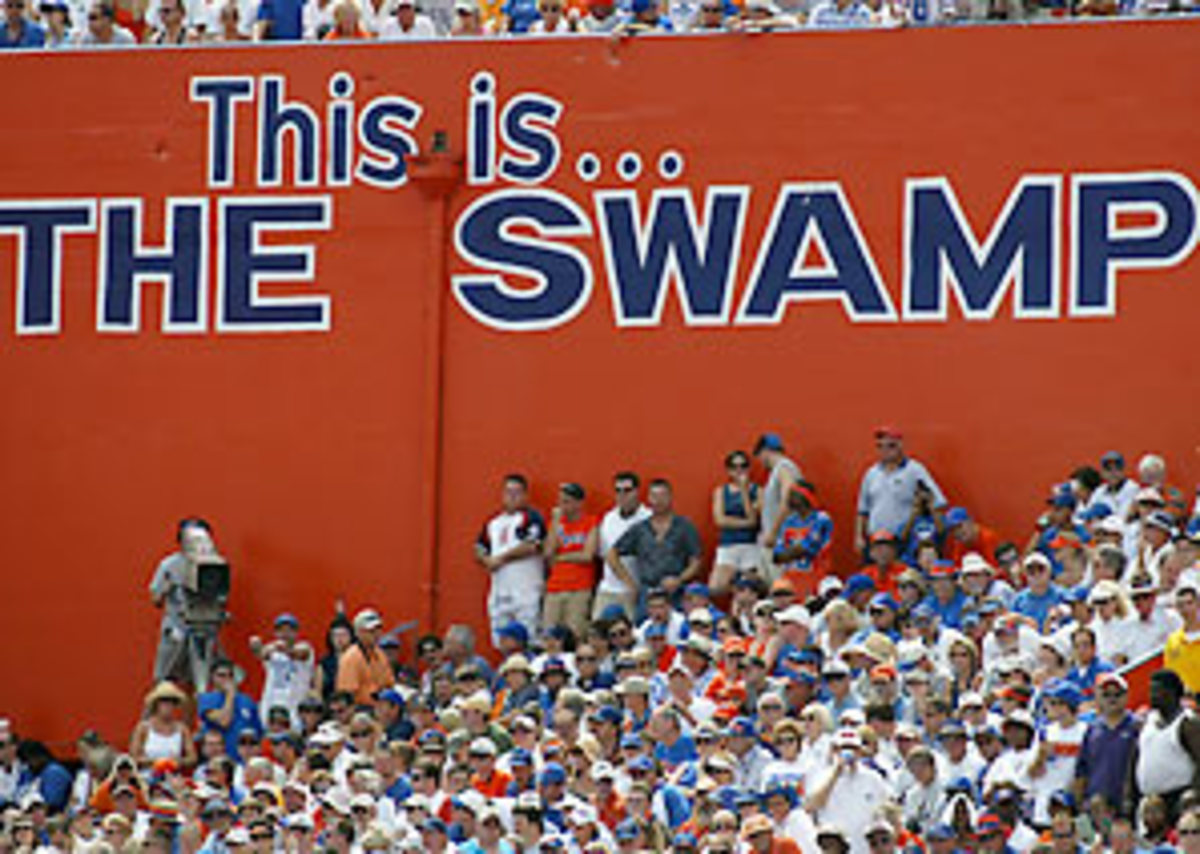Mythbusters
Over time, certain college football non-truths have come to be accepted as absolute fact. So in an effort to educate the increasingly deluded masses, SIOC brings you Mythbusters. (And for the record, this column debunking commonly held myths across the country has nothing to do with that TV show that debunks commonly held myths across the country ... why you'd even make the comparison, I have no idea).
So with hope springing eternal at campus practice fields all over the country, I'll inaugurate this column by shattering one of college football's most enduring myths:
Before the dissection begins, a plea: Hold the e-mails spouting "numbers" and "winning-percentages" and other "facts." If you follow this sport you know the average college football fan doesn't care about "facts" and neither should you.
Every major program believes its home stadium gives it a unique advantage, from the imposing inner-city decrepitude of USC's Coliseum, to the six-figure throngs that congregate at Michigan's Big House (OK, you're right, not even true Blue fans would pretend that that stadium provides any real edge). Across the country, fans truly think that their only-here-and-nowhere-else combination of stadium design, tradition and inner passion provide an extra boost that affects whether a field goal attempt hits the upright or whether an offensive line gets that extra push into the end zone.
Boise State likes to believe its notorious blue turf provides an edge, but come on -- you lost us at "blue turf." Actually, you lost us at "Boise." Fans at the University of Oregon -- despite the fact that Oregonians are some of the nicest people you'll ever meet and therefore by nature can't intimidate -- point to Autzen Stadium as a true difference-maker. Those silly Day-Glo colors, maybe; that stadium, not so much.
But nowhere is home-field advantage assumed to be as important as in the SEC, so that's where I'll focus the debunking efforts.
In Dixie, the myth goes, the fans are just more rabid. It's religion, a matter of life and death, and the mere sight of those jam-packed 90,000-seat monstrosities is enough to make out-of-towners tremble.
Since you probably don't have the attention span for a stadium-by-stadium breakdown, we'll aim our beacon of truth at the two most elite programs in the most elite conference: LSU and Florida.
Not only are the Tigers and Gators the most recent SEC teams to win the national championship, but they also arguably have the two loudest stadiums in the country. Their stadiums even have the best nicknames ("Death Valley" and "The Swamp"). Nevermind that the Bayou Bengals are rumored to have stolen that moniker from Clemson, and that The Swamp had connotations of a program stuck in the mud before Steve Spurrier returned to Gainesville in 1990.
Opposing teams generally get abused in Death Valley and at The Swamp and it's assumed that these edifices actually have something to do with it. At LSU, they're so extreme that their tailgate partying is killing the trees outside the stadium. Sure, visitors to LSU do get torn up, but it's got more to do with the spicy pre-game jambalaya shredding their intestines than with some mystical force within Tiger Stadium.
After all, where was that fanatical advantage when Curley Hallman was the head coach? Or Gerry DiNardo? Or in the 45 years between national titles? Or the 13 years between conference titles? Were the fans just not as passionate then? Did they simply care less and make less noise? Was the mojo in the shop for maintenance?
And in Gainesville, where was that dramatic home-field advantage when the Gators were being humiliated during the Ron Zook era? Where was that edge when the Boys From Old Florida, despite some of the nation's best recruiting classes, were being pounded by the likes of Miami (41-16) and LSU (36-7)? And where was it for basically the entire pre-Spurrier-as-head-coach era?
There are other examples across the conference. The 250,000 fans or so they pack into Rocky Top might think they contributed to Tennessee's gridiron prominence, but where have they been the past few seasons as the Vols have fallen on hard times? Georgia fans think visitors are in trouble when they step Between The Hedges, but come on ... the Peach State wasn't much of a home-field advantage for the Confederacy and for the most part it still isn't.
Even the SEC's most legendary program, Alabama, can't say its home field actually matters all that much. Not after last season's ghastly home loss to Louisiana-Monroe. I mean, what in the name of Stanford-24-USC-23-in-Los-Angeles was that all about?
Simple truth: Death Valley is a tough place to play right now because LSU has a good team. Same thing with The Swamp. And the Horseshoe, and the Coliseum, and everywhere else visiting teams don't stand much of a chance. Those teams might be tough to beat at home, but they're not exactly a cakewalk on the road or in bowl games ... well, except for Ohio State (couldn't resist).
Good teams win at home because they're good. When things go well in front of the home fans, sing the praises of the coaching staff, not the architects (unless you like the analogy that the head coach is the "architect" of the program, but why complicate things). Conversely, a lousy team could play in a Mad Max-style fortress with bloodthirsty screaming hooligans, a shark moat, electrified fences and a fiery death-pit littered with the bones of vanquished opponents (not to be confused with the Beijing Olympics), but the team will still lose if it can't block or tackle.
Remember: Just because college football fans assume it's true, doesn't mean it is.
Got a myth you want us to bust? Contact Phil at mythbusters.sportsillustrated@gmail.com.





